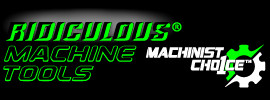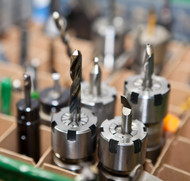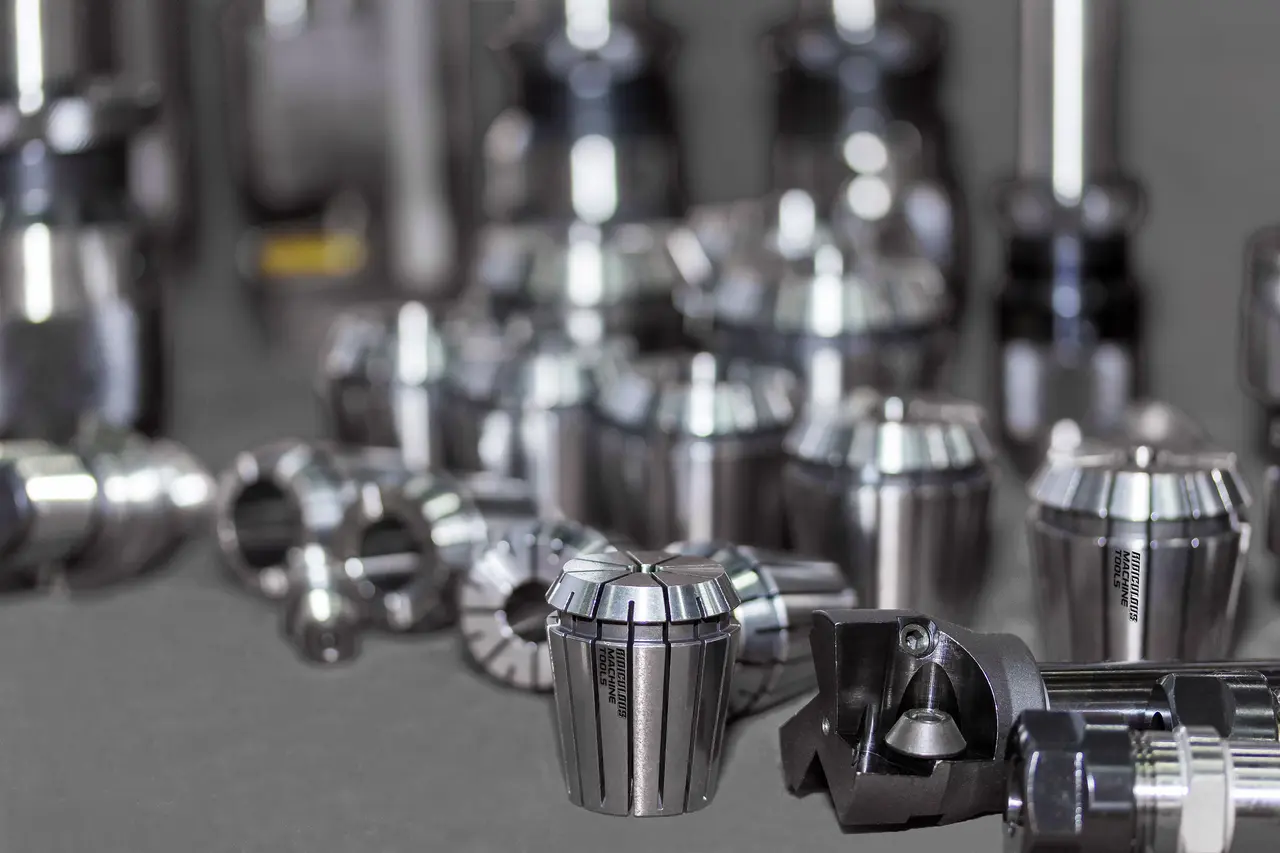ER Collets vs. Other Clamping Systems: Pros and Cons for Machinists
Posted by RMT on Mar 26th 2024
Introduction to ER Collets and Other Clamping Systems
In the realm of machining, the art of securing your tools and workpieces is fundamental. This is where ER collets and various clamping systems step into the spotlight. Picture these systems as the firm grip that steadies everything in place while the machinery works its wonders. ER collets stand out for their popularity, and rightfully so. They are versatile, capable of securing a wide range of tool sizes without hesitation. Yet, they are not the sole contenders in the arena. Other systems like hydraulic chucks, milling chucks, and tapping systems also play their parts, each showcasing unique strengths. Some excel in providing a formidable hold, while others shine in precision or convenience. Grasping the distinctions among these systems and recognizing their individual strengths is essential for machinists aiming to select the optimal fit for their specific requirements. Remember, the key lies in identifying the ideal match for both your machine and your tasks at hand.
What are ER Collets?
ER collets are a clamping system used by machinists to securely hold tools or workpieces in milling machines, lathes, or other machining tools. What makes them unique is their flexibility. Unlike other systems requiring specific sizes for tools, ER collets can accommodate a range of sizes. This eliminates the need to purchase a new collet for every slight difference in tool size; simply adjust the existing ER collet. They operate by compressing the collet with a nut, securely gripping the tool or workpiece. Due to their versatility, ER collets are a popular choice in machining, offering a balance of flexibility, strength, and precision.
Types of Clamping Systems Used in Machining
In machining, clamping systems play a vital role in securing the workpiece to the machine's table or tool within the spindle. Common types include ER collets, milling chucks, hydraulic chucks, and shrink fit holders. ER collets are valued for their versatility, accommodating a wide range of tool diameters. Milling chucks offer strong grip for heavy-duty milling, while hydraulic chucks ensure precise, uniform pressure. Shrink fit holders provide accuracy and robust holding power by expanding and shrinking around the tool. Each system has its advantages and disadvantages based on specific job requirements such as precision, tool size, and material. Choosing the appropriate clamping system can significantly impact machining outcomes.
Pros of ER Collets
ER collets are favored by machinists for their flexibility, enabling the secure clamping of tools of varying diameters while maintaining precision and grip. This adaptability facilitates quick task-switching, enhancing productivity by saving time. Furthermore, ER collets boast a broad clamping range, making them ideal for workshops handling diverse projects. Renowned for their robust grip, they are essential for heavy-duty machining, ensuring tool stability. Their straightforward design simplifies usage and maintenance, minimizing downtime and maximizing efficiency. Additionally, ER collets are a cost-effective choice due to their durability and the elimination of the need for multiple holders, making them a wise investment for operations of all sizes. In essence, ER collets offer versatility, strong grip, simplicity, and cost-efficiency.
Cons of ER Collets
ER collets have their drawbacks that machinists should be aware of. Firstly, precise tightening is crucial. Incorrect tightening can result in reduced tool life and potential workpiece damage. Finding the correct balance can be challenging without experience. Additionally, ER collets have a limited gripping range, typically around 1mm. This means that not all tool sizes can be accommodated without sacrificing grip strength. As a result, machinists may need to invest in a variety of collet sizes, increasing overall costs. Speaking of costs, while ER collets themselves are affordable, the initial setup with a quality chuck and multiple collet sizes can be expensive. Lastly, ER collets are not ideal for high-speed applications as they can cause tool imbalance at high RPMs, impacting machining precision and finish. In conclusion, although ER collets are commonly used and versatile, their limitations in precision, grip range, cost, and high-speed performance should be taken into account.
Comparing ER Collets with Other Clamping Systems
When it comes to holding tools in place, machinists have a range of options, but ER collets and other clamping systems are often at the top of the list. ER collets stand out because they're versatile, handling a wide range of tool diameters with precision. This means you won't need a different clamping device for every tool size, saving both time and money. Other systems, like hydraulic or milling chucks, specialize in high grip strength or ease of use but can be more costly and less flexible. Here's a quick breakdown:
ER Collets: They're the go-to for a reason. ER collets offer a solid grip and accuracy for various tool sizes without breaking the bank. They're easy to find and replace, making them a reliable choice for different machining tasks.
Hydraulic Chucks: Great for high-speed applications, hydraulic chucks deliver exceptional clamping force and vibration dampening, which is a plus for delicate operations. The downside? They're more expensive and not as versatile when it comes to tool sizes.
Milling Chucks: If you're after unbeatable grip strength, milling chucks have got your back. They're perfect for heavy-duty milling where tool pullout is a concern. However, like hydraulic chucks, they limit flexibility in tool size and come with a higher price tag.
Each system has its pros and cons, so it's about finding the right fit for your work. ER collets are a solid, all-around choice for versatility and value, while hydraulic and milling chucks might be worth the investment for specialized tasks. Consider what you need most in your work to make the best decision.
Key Advantages of Other Clamping Systems
Other clamping systems, while differing from ER collets, possess their unique strengths. A prominent advantage is specificity; certain systems are tailored for specific tasks, ensuring excellent performance. For example, hydraulic and pneumatic chucks excel in high-precision applications, offering consistency and minimal setup time, which can be a game-changer in operations requiring utmost accuracy. Quick-change systems stand out by significantly reducing tool changeover time, boosting productivity in high-volume environments. Meanwhile, shrink fit holders provide superior holding strength and balance, critical for high-speed machining, ensuring both safety and precision. Each of these systems serves distinct needs, making them indispensable in scenarios where the flexibility of ER collets might fall short.
Disadvantages of Alternative Clamping Systems
When we talk about ER collets, many machinists prefer them over alternative clamping systems for several reasons. However, it's not just about why ER collets stand out; it's also crucial to understand where other systems might fall short. First off, traditional vise or chuck systems have limited flexibility. They can't always hold onto odd-shaped materials as securely or as gently as ER collets. This means you might struggle when working with materials that aren't perfectly round or square.
Another point is speed. Changing out workpieces in vises or chucks can take significantly more time compared to quickly swapping out an ER collet. This eats into precious manufacturing time, especially in high-volume settings. Then, there's precision. While some alternative clamping systems are precise, they often can't match the uniform pressure and minimal runout provided by ER collets. This precision is critical for jobs requiring extreme accuracy.
Tool life is another concern. Alternative systems might not distribute pressure as evenly as ER collets, leading to increased wear on your tools or even the workpiece. This means more money spent on replacements and potential inconsistencies in your work.
Finally, consider the cost. While some clamping systems might seem cheaper upfront, the lack of versatility and potential for increased tool wear can lead to higher expenses over time. ER collets, with their durability and flexibility, often present a more cost-effective option in the long run. In summary, while alternative clamping systems have their place, the limitations in flexibility, speed, precision, tool life, and overall cost make ER collets a superior choice for many machinists.
How to Choose the Right Clamping System for Your Needs
Selecting the right clamping system is crucial for any machinist. It's not just about holding your tool; it's about precision, longevity, and efficiency. Here's what you need to consider: workpiece size, tool type, and the machining operation. Big or irregularly shaped workpieces? ER collets, with their wide clamping range, could be your best bet. Working with high-speed tools? Look into systems designed for minimal vibration. For heavy-duty operations, consider options that promise maximum gripping strength and stability. Remember, your choice can directly affect the quality of your work and tool lifespan. Also, factor in maintenance and setup times. Some systems are more user-friendly, saving valuable minutes or even hours over time. In short, the right clamping system depends on your specific needs. Assess, compare, and choose wisely.
Conclusion: Summarizing the Best Choice for Machinists
Choosing between ER collets and other clamping systems boils down to what you value most in your machining processes. ER collets are widely praised for their flexibility, accuracy, and wide range of clamping diameters, making them a solid choice for most applications. They're especially suited for tasks requiring high precision and versatility. On the flip side, alternative systems may offer benefits like greater clamping force or ease of use for specific types of jobs. However, remember that the initial investment and ongoing costs can vary significantly. Ultimately, the best choice for a machinist hinges on the specific needs of their projects and personal preferences.ER collets stand out for their adaptability and reliability across various tasks, making them a staple in many machine shops.



